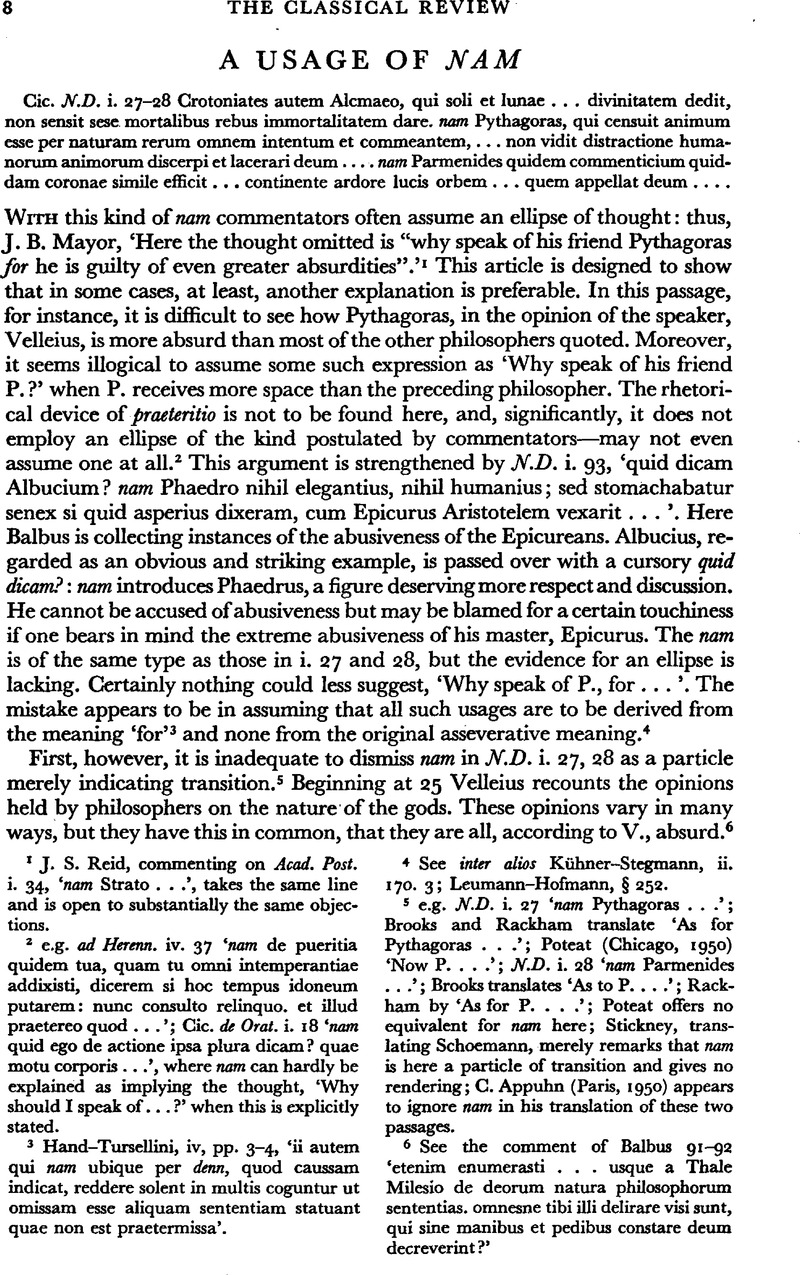No CrossRef data available.
Article contents
A Usage of Nam
Published online by Cambridge University Press: 13 February 2009
Abstract

- Type
- Review Article
- Information
- Copyright
- Copyright © The Classical Association 1952
References
page 8 note 1 J. S. Reid, commenting on Acad. Post. i. 34, ‘nam Strato …‘, takes the same line and is open to substantially the same objections.
page 8 note 2 e.g. ad Heroin, iv. 37 ‘ nam de pueritia quidem tua, quam tu omni intemperantiae addixisti, dicerem si hoc tempus idoneum putarem: nunc consulto relinquo. et illud praetereo quod … ’; Cic. de Oral. i. 18 ‘nam transquid ego de actione ipsa plura dicam? quae motu corporis …’, where nam can hardly be explained as implying the thought, ‘ Why should I speak of … ? ’ when this is explicitly stated.
page 8 note 3 Hand-Tursellini, iv, pp. 3–4, ‘ ii autem qui nam ubique per denn, quod caussam indicat, reddere solent in multis coguntur ut omissam esse aliquam sententiam statuant quae non est praetermissa?.
page 8 note 4 See inter olios Kühner-Stegmann, ii. 170.3; Leumann-Hofmann, § 252.
page 8 note 5 e.g. N.D. i. 27 ‘ nam Pythagoras …’; Brooks and Rackham translate ‘ As for Pythagoras …’; Poteat (Chicago, 1950) ‘ Now P.… ’; N.D. i. 28 ‘ nam Parmenides … ’; Brooks translates ‘As to P.… ’; Rack- ham by ‘ As for P.… ’; Poteat offers no equivalent for nam here; Stickney, transquid lating Schoemann, merely remarks that nam is here a particle of transition and gives no rendering; C. Appuhn (Paris, 1950) appears to ignore nam in his translation of these two passages.
page 8 note 6 See the comment of Balbus 91–92 ‘etenim enumerasti … usque a Thale Milesio de deorum natura philosophorum sententias. omnesne tibi illi delirare visi sunt, qui sine manibus et pedibus constare deum decreverint?’
page 9 note 1 ii, p. 374 ‘at non ipsa caussa indicatur his vocabulis(sc. nam and enim) sed veritas alicuius sententiae ex veritate alius sententiae demonstratur’.
page 9 note 2 e.g. Acad. Post. i. 9 ‘tum, ego “sunt”, inquam, “ista, Varro, nam nos in nostra urbe peregrinantis errantisque tamquam hospites tui libri quasi domum deduxerunt, ut possemus aliquando qui et ubi essemus agnoscere“; Sail. Jug. 31. 2 ‘nam ilia quidem piget …’; Plaut. Am.605–6 ‘Am. huic homini nescio quid est mali … Sos.fateor: nam sum obtusus pugnis pessume’. It is generally admittedthat nam is still an asseverative particle in Plautus. What is suggested here is that this original meaning is at the basis of several later uses, especially in Cicero. Cicero's failure in de Invent, i. 95 to understand thenam (‘for instance’) in Plaut. Trin. 25 ff. (see Lindsay, W. M., Syntax of Plautus, p. 100)Google Scholar is not conclusive against similar usages by Cicero himself in the face of the evidence that canbe brought. In particular, (i) the use of nam with mehercule and hercule respectively in two passages of Cicero (in Verr. ii. 1. 133 ‘ “nam mehercule”, inquit, “sic agamus: columnae ad perpendiculum exigantur” ’ and ib. a. 72‘“nam hercule”, inquit Q,. Minucius, “me quoque Petilius ut sibi in consilio adessem rogavit“’) seems exactly paralle to the use with hercle or edepol in Roman Comedy (e.g Plaut. Capt. 896; Ter. Ad. 190 ff. and Plaut. Mil. 1226; Capt. 604), and can be most easily explained as a development of the asseverative meaning; (ii) instances closely resembling some of the later usages are already to be found in Plautus: see examples in Lindsay, op. cit., pp. 100–1 and also Plaut. Am. 552 ‘Am. scelestissimum te arbitror. Sos. me? nam quam ob rem?‘(‘But why?’) and cf. Cic. in Verr. ii. 3. 196,‘“mini frumentum non opus est: nummos volo.” “nam speraveram”, inquit arator, “ me ad denarios venturum”4 (‘But I had hoped …’)—perhaps a partial anticipation of the adversative use of nam in later Latin, on which see Löfstedt, E., Coniectanea, pp. 55 ff.Google Scholar: this is not to dispute the main conclusions of that chapter, but merely to claim that for some considerable time the meanings ‘indeed’ and ‘for’ existed concurrently and occasionally almost indistinguishably.
page 9 note 3 Georges, after giving instances in which nam can be translated by zum Beispiel (cf. καľ γ⋯), then proceeds to explain that it is used mehrmals bei mehreren nacheinander ange-führten Beispielen, thus giving the usage proper classification.
page 9 note 4 Peterson suggests inter alia ‘likewise’ for nam in Quint, x. 1. 12, although he assumes an ellipse here.
page 10 note 5 Cf. also Quint, x. i. 81–84 (the list of eloquent philosophers in which Theophrastus provides a further instance, 83 ‘ nam in Theophrasto … ‘), Petron. 38. 4 ‘ nam mulam quidem nullam habet quae non ex onagro nata sit’, in which nam introduces yet another example of Trimalchio's practice of importing in order to obtain the best. He imports rams from Tarentum in order to have the best sheep, bees from Athens in order to have the best honey, etc., and similarly he brings in wild asses, instead of breeding from domesticated ones, in order to have the best mules. E. V. Marmorale's comment, ‘ nam ha assai spesso in Petronio un significato assai tenue, che oscilla fra “inoltre” e “e”’, appears to do this nam less than justice: so also that of Perrochat; ‘ nam sert souvent a introduire une autre idée, un autrefait, “quant à”; fréquent avec cette valeur dans la Cena’: Friedländer assumes an ellipse.


